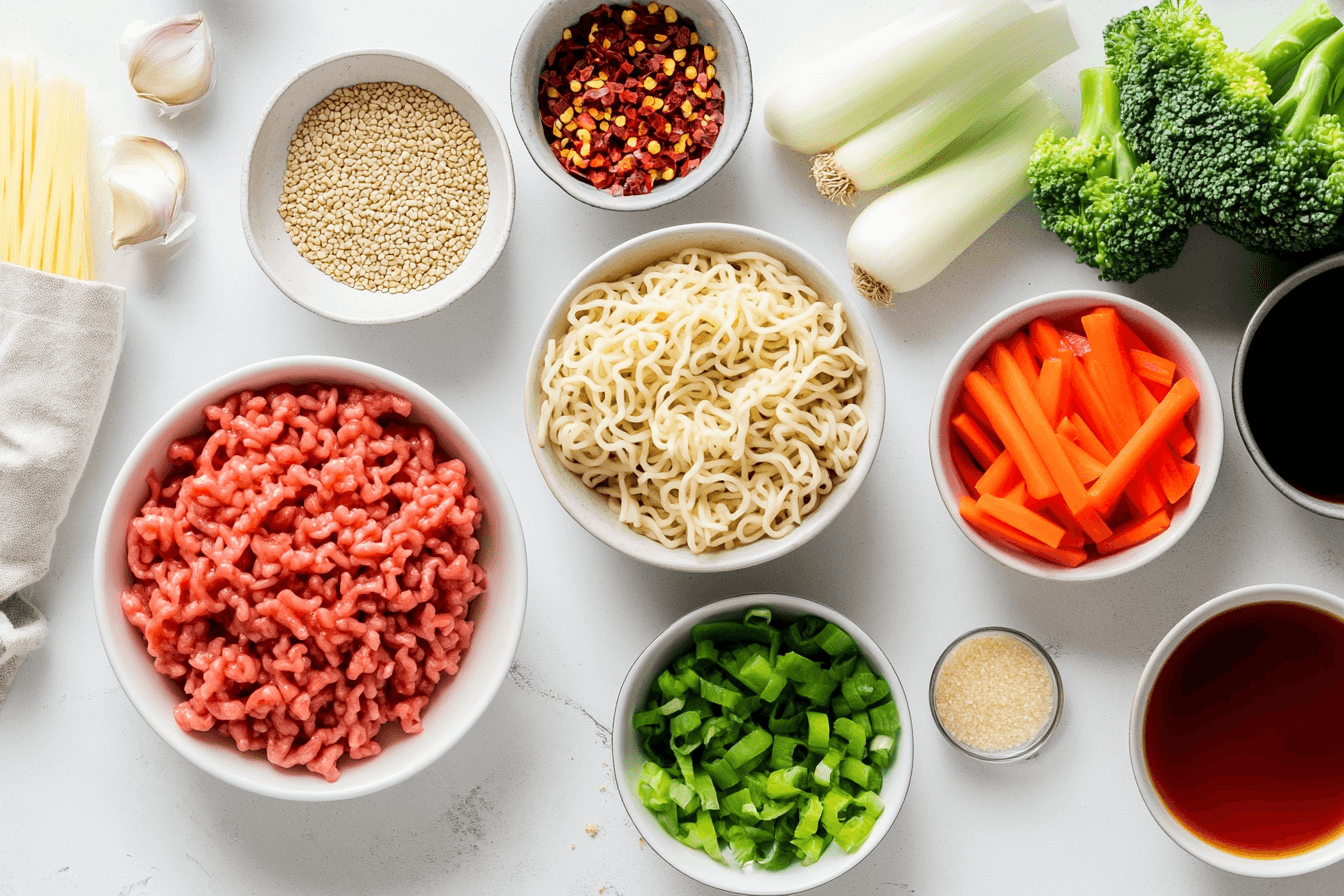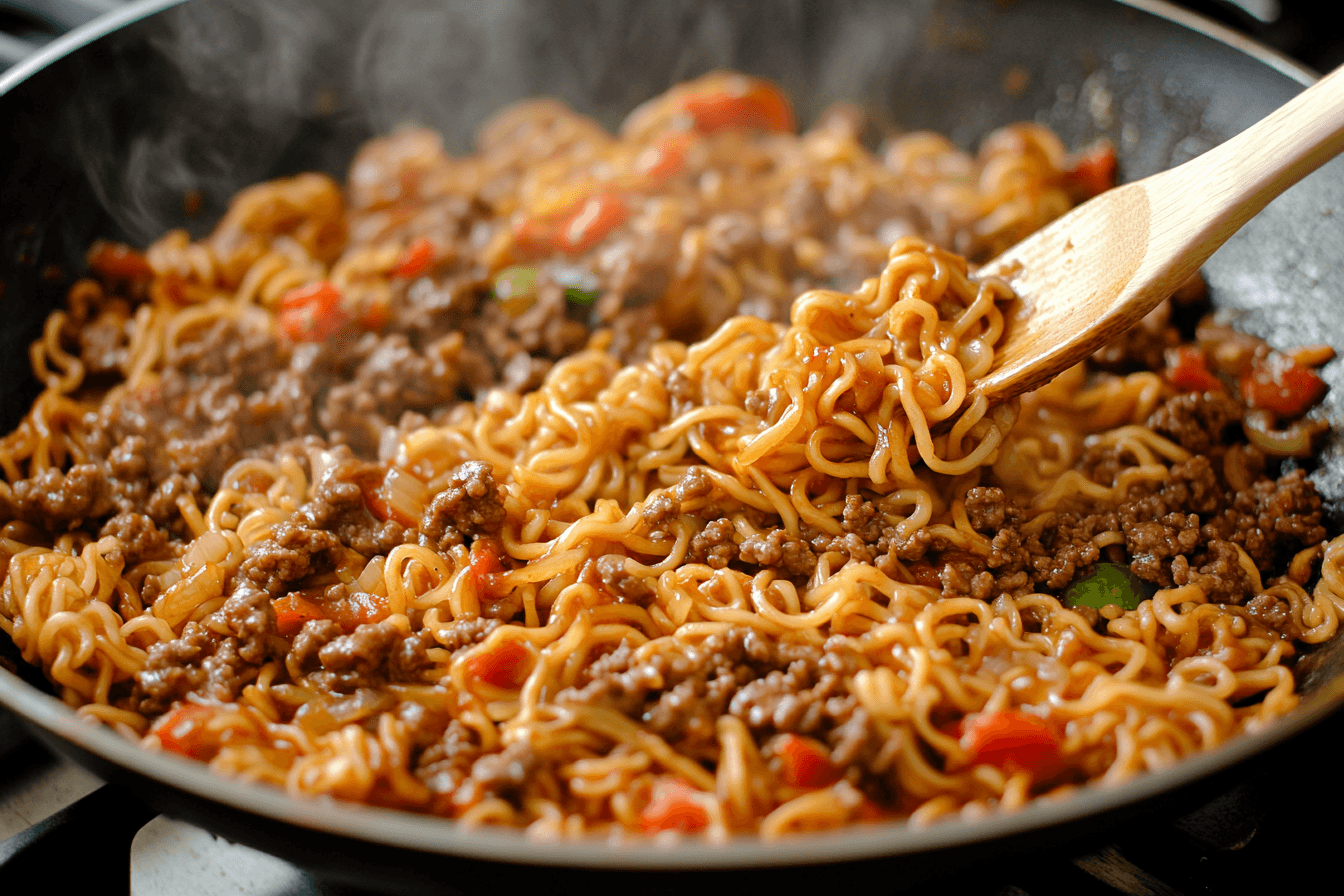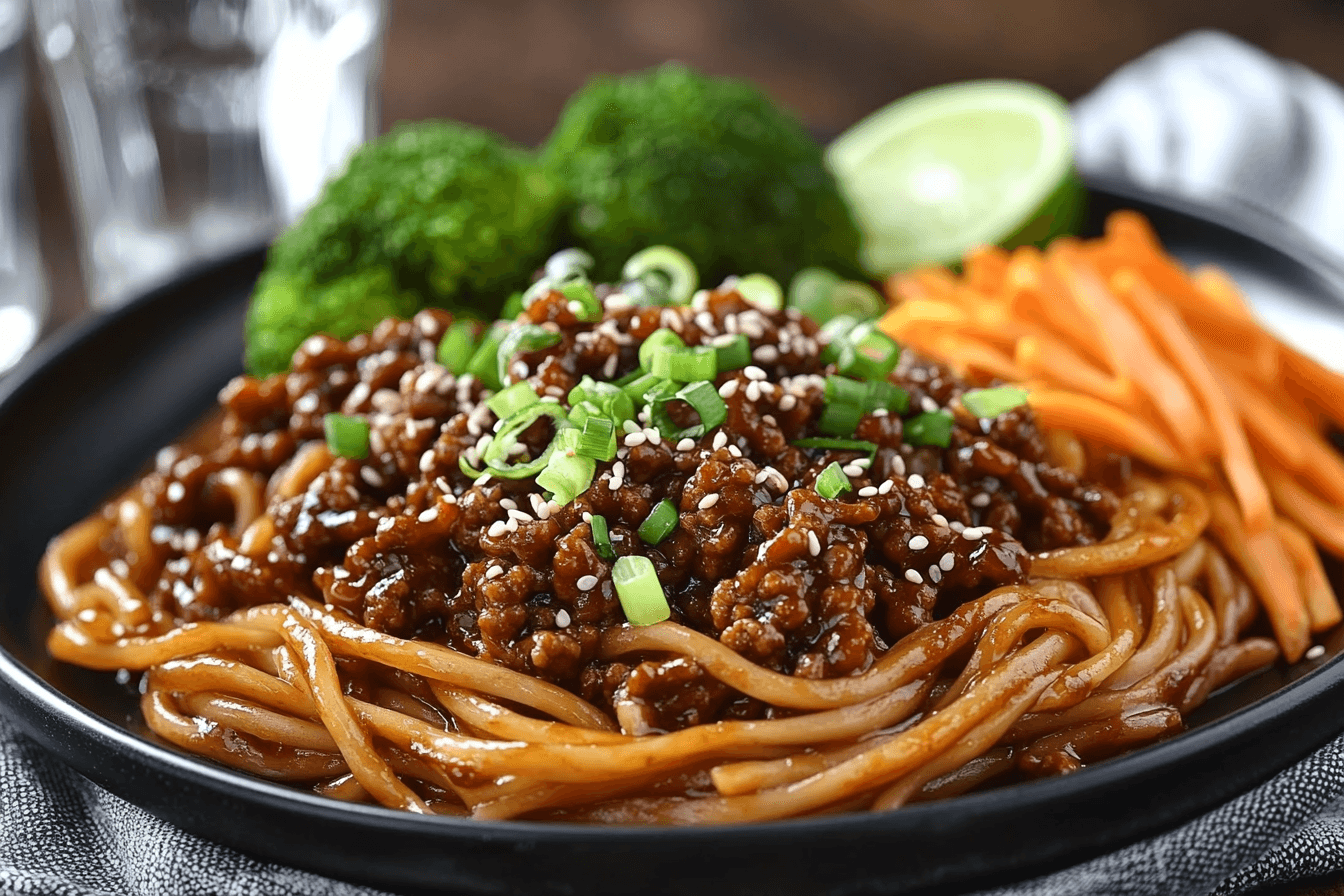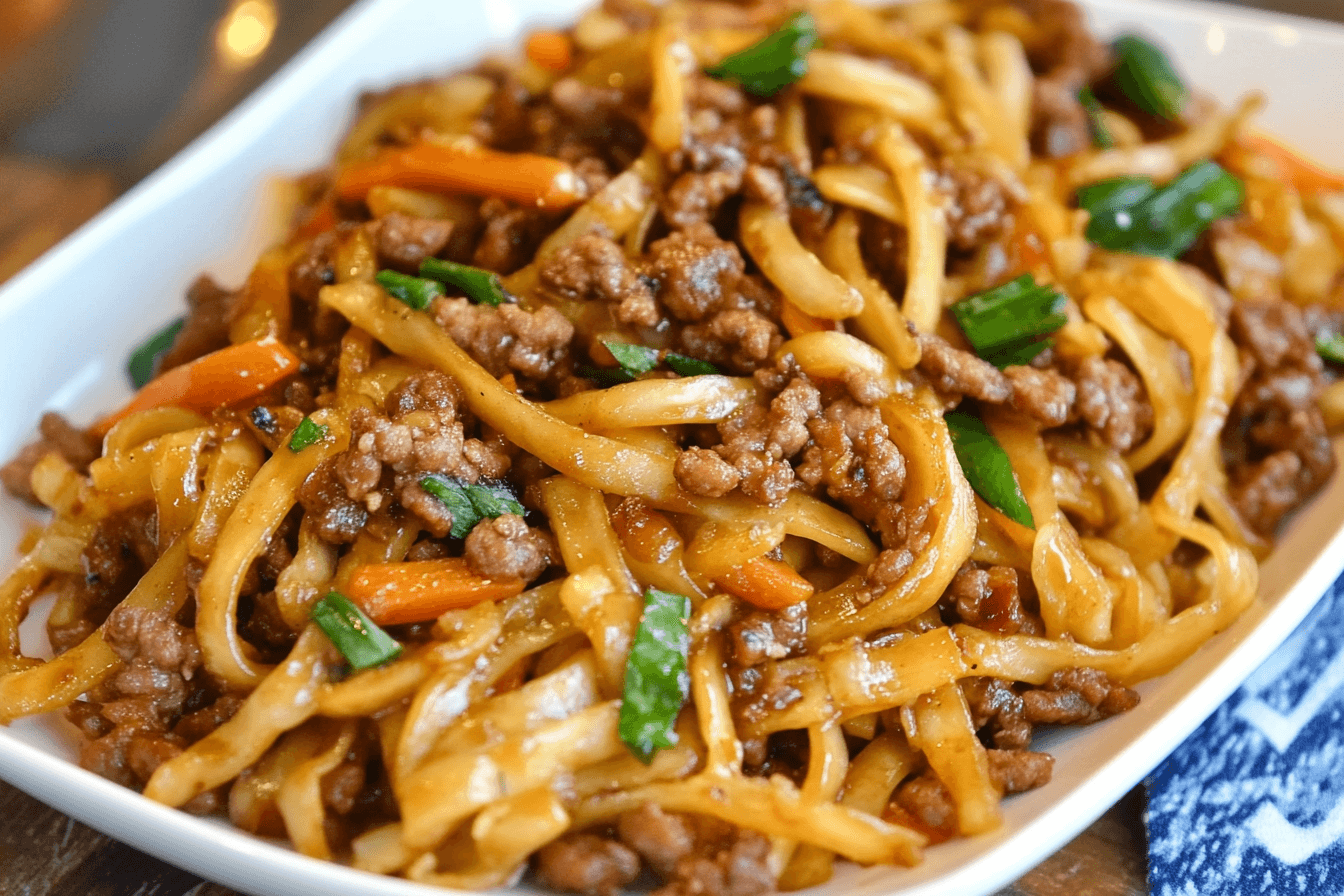If you’ve ever found yourself craving a dish that’s both comforting and bursting with flavor, Mongolian Ground Beef Noodles might just be your next obsession. Imagine tender ground beef, perfectly cooked noodles, and a savory-sweet sauce that ties everything together. Sounds delicious, right? Well, buckle up, because we’re about to dive deep into the world of this mouthwatering dish. Whether you’re a seasoned home cook or a newbie in the kitchen, this article will guide you through everything you need to know about Mongolian Ground Beef Noodles—from its origins to how to make it at home, and even how to troubleshoot common cooking problems. Let’s get started!
Table of Contents
Introduction to Mongolian Ground Beef Noodles
What Are Mongolian Ground Beef Noodles?
Mongolian Ground Beef Noodles are a delightful fusion of savory ground beef, chewy noodles, and a rich, umami-packed sauce. Think of it as the lovechild of stir-fry and comfort food. The dish is known for its bold flavors, combining sweet, salty, and slightly spicy elements that make it irresistible. It’s quick to prepare, making it a perfect weeknight dinner option, yet impressive enough to serve at a casual gathering.
But here’s the thing: despite its name, Mongolian Ground Beef Noodles aren’t actually from Mongolia. Confused? Don’t worry, we’ll get to that in a bit. For now, just know that this dish is a staple in many Asian-inspired restaurants and has won the hearts of food lovers worldwide.
The History and Origin of Mongolian Beef Noodles
Let’s clear up the confusion right away. Despite its name, Mongolian Beef—and by extension, Mongolian Ground Beef Noodles—isn’t traditionally Mongolian. In fact, it’s believed to have originated in Chinese-American cuisine. The dish was likely created to appeal to Western palates, combining familiar ingredients with Asian cooking techniques.
The name “Mongolian” might have been chosen to evoke a sense of exoticism, but the flavors are more closely tied to Chinese stir-fry dishes. The use of soy sauce, brown sugar, and garlic gives it that signature sweet-and-savory profile that we all love. Over time, the dish has evolved, with ground beef becoming a popular variation for its ease of preparation and affordability.
“Food is not just eating energy. It’s an experience.” – Guy Fieri
And what an experience Mongolian Ground Beef Noodles are! They’re a testament to how food can travel across cultures, adapt, and become something entirely new and delicious.
Why Mongolian Ground Beef Noodles Are a Must-Try Dish
The Perfect Blend of Flavors and Textures
One of the reasons Mongolian Ground Beef Noodles are so addictive is the harmony of flavors and textures. The dish starts with ground beef, which is browned to perfection, creating a rich, meaty base. Then come the noodles—soft, chewy, and satisfying. But the real star of the show is the sauce. A combination of soy sauce, brown sugar, garlic, and ginger creates a symphony of sweet, salty, and umami flavors that dance on your taste buds.
And let’s not forget the texture! The tender beef, the slightly chewy noodles, and the crisp vegetables (if you choose to add them) create a delightful contrast that keeps every bite interesting. It’s like a party in your mouth, and everyone’s invited.
Health Benefits of Mongolian Ground Beef Noodles
Now, you might be thinking, “This sounds delicious, but is it healthy?” The answer is: it can be! While the dish is undeniably indulgent, it’s also packed with nutrients. Ground beef is a great source of protein and iron, while the noodles provide carbohydrates for energy. If you add vegetables like bell peppers, carrots, or broccoli, you’re also getting a dose of vitamins and fiber.
Plus, you can easily tweak the recipe to suit your dietary needs. Use lean ground beef or even ground turkey for a lighter option. Swap out regular noodles for whole wheat or zucchini noodles (zoodles) if you’re watching your carb intake. The possibilities are endless!
How to Make Authentic Mongolian Ground Beef Noodles at Home
Essential Ingredients for Mongolian Ground Beef Noodles
Before we dive into the cooking process, let’s talk about the ingredients. Here’s what you’ll need to make a basic version of Mongolian Ground Beef Noodles:
- Ground beef: The star of the dish. Opt for lean ground beef if you prefer a lighter option.
- Noodles: You can use udon, rice noodles, or even spaghetti if that’s what you have on hand.
- Soy sauce: This is the backbone of the sauce, providing that salty, umami flavor.
- Brown sugar: Adds sweetness to balance out the saltiness of the soy sauce.
- Garlic and ginger: These aromatics add depth and complexity to the dish.
- Vegetables (optional): Bell peppers, carrots, and broccoli are great additions.
- Green onions: For garnish and a fresh, oniony kick.

Step-by-Step Cooking Instructions
Ready to cook? Let’s break it down step by step:
- Cook the noodles: Start by boiling your noodles according to the package instructions. Once cooked, drain and set aside.
- Brown the beef: In a large skillet or wok, cook the ground beef over medium heat until it’s browned and cooked through. Drain any excess fat.
- Prepare the sauce: In a small bowl, mix together soy sauce, brown sugar, minced garlic, and grated ginger. This is where the magic happens!
- Combine everything: Add the cooked noodles and sauce to the skillet with the beef. Toss everything together until the noodles are well-coated and heated through.
- Add vegetables (optional): If you’re using vegetables, stir them in at this point and cook until they’re tender-crisp.
- Garnish and serve: Top with sliced green onions and serve hot. Enjoy!

Tips for Perfecting Your Mongolian Ground Beef Noodles
- Don’t overcook the noodles: You want them to be tender but still have a bit of bite. Overcooked noodles can turn mushy and ruin the texture of the dish.
- Adjust the sauce to your taste: If you like it sweeter, add a bit more brown sugar. If you prefer it saltier, add more soy sauce. Cooking is all about making it your own!
- Use fresh garlic and ginger: While powdered versions can work in a pinch, fresh garlic and ginger will give your dish a much more vibrant flavor.
Common Problems When Making Mongolian Ground Beef Noodles
Let’s face it—cooking isn’t always smooth sailing. Even the most experienced home cooks run into issues from time to time. But don’t worry, I’ve got your back. Here are some common problems you might encounter when making Mongolian Ground Beef Noodles, along with easy solutions to fix them.
Problem 1: The Noodles Are Too Sticky or Overcooked
We’ve all been there. You’re excited to dig into your Mongolian Ground Beef Noodles, only to find that the noodles have turned into a sticky, mushy mess. Not exactly appetizing, right?
Solution: How to Cook Noodles Perfectly Every Time
The key to avoiding sticky or overcooked noodles is all in the cooking process. Here’s what you need to do:
- Use plenty of water: When boiling noodles, make sure you’re using a large pot with plenty of water. This prevents the noodles from sticking together.
- Salt the water: Add a generous pinch of salt to the boiling water. This not only flavors the noodles but also helps them cook more evenly.
- Follow the package instructions: Different types of noodles have different cooking times. Keep an eye on the clock and test the noodles a minute or two before the recommended time to ensure they’re al dente.
- Rinse with cold water (optional): If you’re not using the noodles right away, rinse them under cold water to stop the cooking process and prevent them from sticking.
“Cooking is like love. It should be entered into with abandon or not at all.” – Harriet Van Horne
So, don’t be afraid to experiment and find what works best for you. Cooking is as much about the journey as it is about the destination!
Problem 2: The Dish Lacks Flavor or Depth
You’ve followed the recipe to a T, but something’s missing. The dish tastes bland, and you’re left wondering where you went wrong. Sound familiar?
Solution: Enhancing the Flavor Profile with Key Ingredients
The beauty of Mongolian Ground Beef Noodles lies in its bold, complex flavors. If your dish is falling flat, here are a few ways to amp up the flavor:
- Add more aromatics: Garlic and ginger are the backbone of this dish. If you feel like the flavor is lacking, try adding more of these ingredients. Fresh is always best!
- Experiment with sauces: Soy sauce is a must, but you can also add a splash of hoisin sauce, oyster sauce, or even a bit of chili garlic sauce for an extra kick.
- Don’t forget the acid: A squeeze of lime juice or a dash of rice vinegar can brighten up the dish and balance out the richness of the sauce.
- Toast your spices: If you’re using any dried spices (like red pepper flakes), toast them in the pan before adding the beef. This releases their oils and intensifies their flavor.
Problem 3: The Beef Turns Out Tough or Chewy
There’s nothing worse than biting into a piece of beef that’s tough and chewy. It can ruin an otherwise perfect dish. So, how do you ensure your ground beef stays tender and juicy?
Solution: Tenderizing and Cooking Beef to Perfection
- Choose the right cut: If you’re using ground beef, opt for a higher fat content (like 80/20). The fat helps keep the meat moist and flavorful.
- Don’t overcrowd the pan: If you’re cooking a large batch, cook the beef in batches to avoid overcrowding the pan. This ensures even cooking and prevents the beef from steaming instead of browning.
- Cook on medium heat: High heat can cause the beef to cook too quickly, resulting in a tough texture. Medium heat allows the beef to cook evenly and retain its moisture.
- Add a bit of moisture: If you’re worried about the beef drying out, add a splash of beef broth or water while cooking. This helps keep the meat tender.
Variations of Mongolian Ground Beef Noodles
One of the best things about Mongolian Ground Beef Noodles is how versatile it is. You can tweak the recipe to suit your taste preferences or dietary needs. Here are a few delicious variations to try:
Spicy Mongolian Ground Beef Noodles
If you’re a fan of heat, this variation is for you. Simply add some red pepper flakes, sriracha, or chili garlic sauce to the dish. You can also toss in some sliced jalapeños for an extra kick. The spiciness pairs beautifully with the sweet and savory flavors of the sauce.
Vegetarian Mongolian Noodles (Beef Substitute)
Not a meat eater? No problem! You can easily make a vegetarian version of this dish by substituting the ground beef with plant-based alternatives like crumbled tofu, tempeh, or even mushrooms. The sauce and noodles will still shine, giving you a satisfying and flavorful meal. If you’re a fan of veggie-packed dishes, check out our guide on Costco Stuffed Bell Peppers, a delicious and nutritious option for your table.
Low-Carb Mongolian Ground Beef Zoodles
Watching your carb intake? Swap out the traditional noodles for zucchini noodles (zoodles). They’re light, healthy, and a great way to sneak in some extra veggies. Just be sure not to overcook them—zoodles are best when they’re tender-crisp.
Pairing Mongolian Ground Beef Noodles with Sides and Drinks
Best Side Dishes to Complement Mongolian Noodles
While Mongolian Ground Beef Noodles are delicious on their own, they’re even better when paired with the right sides. Here are a few ideas:
- Steamed vegetables: Broccoli, bok choy, or snap peas add a fresh, crunchy contrast to the rich noodles.
- Spring rolls: Crispy spring rolls are a classic pairing and add a fun texture to the meal.
- Asian slaw: A light, tangy slaw can help balance out the richness of the dish.

Recommended Drinks to Pair with Mongolian Ground Beef Noodles
What’s a great meal without a great drink? Here are a few beverages that pair perfectly with Mongolian Ground Beef Noodles:
- Green tea: The light, refreshing flavor of green tea complements the bold flavors of the dish.
- Asian beer: A crisp lager or pilsner can help cut through the richness of the sauce.
- Sparkling water with lime: For a non-alcoholic option, try sparkling water with a squeeze of lime. It’s refreshing and palate-cleansing.
Storing and Reheating Mongolian Ground Beef Noodles
Let’s be real—sometimes you make a big batch of Mongolian Ground Beef Noodles, and there’s just no way you’re finishing it all in one sitting. But don’t worry, this dish stores and reheats beautifully if you do it right. Here’s how to keep your leftovers tasting fresh and delicious.
How to Store Leftovers Properly
Storing your Mongolian Ground Beef Noodles correctly is key to maintaining their flavor and texture. Here’s what you need to do:
- Let it cool: Allow the dish to cool to room temperature before storing. This prevents condensation from forming in the container, which can make the noodles soggy.
- Use airtight containers: Transfer the noodles and beef into an airtight container. Glass containers are great because they don’t absorb odors, but plastic works too.
- Separate the noodles and sauce (optional): If you’re planning to store the dish for more than a day, consider storing the noodles and sauce separately. This helps prevent the noodles from absorbing too much liquid and becoming mushy.
- Refrigerate or freeze: Store the dish in the fridge for up to 3 days or in the freezer for up to 2 months. If freezing, make sure to label the container with the date.
Tips for Reheating Without Losing Flavor or Texture
Reheating Mongolian Ground Beef Noodles can be tricky—nobody wants a dry, rubbery mess. Here’s how to bring your leftovers back to life:
- Stovetop method: The stovetop is the best way to reheat this dish. Add a splash of water or broth to a skillet and heat the noodles and beef over medium heat, stirring occasionally. This helps rehydrate the noodles and keeps the beef tender.
- Microwave method: If you’re short on time, the microwave works too. Place the noodles in a microwave-safe dish, sprinkle a few drops of water over them, and cover with a microwave-safe lid or damp paper towel. Heat in 30-second intervals, stirring in between, until warmed through.
- Add fresh garnishes: Once reheated, top with fresh green onions or a sprinkle of sesame seeds to revive the flavors and add a bit of texture.
“Leftovers are the best part of cooking. They’re like a gift to your future self.” – Unknown
And honestly, isn’t it the best feeling when you open the fridge and find a container of delicious Mongolian Ground Beef Noodles waiting for you? It’s like a little culinary hug.
Frequently Asked Questions About Mongolian Ground Beef Noodles
Got questions? I’ve got answers! Here are some of the most common questions people have about Mongolian Ground Beef Noodles, along with my best advice.
Can I Use Ground Chicken or Pork Instead of Beef?
Absolutely! Ground chicken or pork can be great substitutes for beef. Chicken will give you a lighter, milder flavor, while pork adds a richer, slightly sweet taste. Just keep in mind that cooking times may vary slightly depending on the meat you use.
Are Mongolian Ground Beef Noodles Gluten-Free?
They can be! Traditional recipes use soy sauce, which contains gluten, but you can easily swap it out for tamari or a gluten-free soy sauce alternative. Also, make sure to use gluten-free noodles, such as rice noodles or zucchini noodles.
How Can I Make This Dish Kid-Friendly?
If you’re cooking for picky eaters, here are a few tips to make Mongolian Ground Beef Noodles more kid-friendly:
- Tone down the spice: Skip the chili flakes or spicy sauces and stick to a milder flavor profile.
- Add familiar veggies: Use vegetables your kids already love, like carrots or peas.
- Let them customize: Set up a “noodle bar” where kids can add their own toppings, like shredded cheese or extra green onions. It’s fun and encourages them to try new things!
The Cultural Significance of Mongolian Ground Beef Noodles
Mongolian Cuisine and Its Global Influence
While Mongolian Ground Beef Noodles may not be traditionally Mongolian, they’re a great example of how food evolves and adapts across cultures. Mongolian cuisine itself is rooted in the nomadic lifestyle of the Mongolian people, with a focus on hearty, protein-rich dishes like mutton, beef, and dairy products. The flavors are simple but robust, designed to sustain people through harsh climates.
The dish we know as Mongolian Beef (and its noodle variation) is more of a Westernized interpretation, blending Asian flavors with familiar ingredients. It’s a testament to the global influence of food and how it can bring people together, even across vast distances.
How Mongolian Ground Beef Noodles Reflect Traditional Cooking
While the dish may not be traditional, it does reflect some key elements of Mongolian and Asian cooking:
- Use of beef: Beef is a staple in Mongolian cuisine, so it’s no surprise that it’s the star of this dish.
- Simple, bold flavors: Mongolian cooking often relies on a few key ingredients to create big, satisfying flavors—much like the soy sauce, garlic, and ginger in this dish.
- Versatility: Nomadic cultures are all about making the most of what’s available, and this dish is incredibly adaptable. You can tweak it to suit your tastes or use whatever ingredients you have on hand.
Conclusion: Why Mongolian Ground Beef Noodles Deserve a Spot in Your Recipe Collection
Final Thoughts and Encouragement to Try the Recipe
If you haven’t already added Mongolian Ground Beef Noodles to your recipe rotation, what are you waiting for? This dish is the perfect combination of comfort food and bold, exciting flavors. It’s easy to make, endlessly customizable, and guaranteed to satisfy even the pickiest eaters.
Whether you’re cooking for a weeknight dinner, meal prepping for the week, or impressing guests at a casual gathering, Mongolian Ground Beef Noodles are a winner. Plus, they’re a great way to explore new flavors and techniques in the kitchen.
Share Your Experience and Feedback
I’d love to hear how your Mongolian Ground Beef Noodles turn out! Did you add your own twist? Did your family gobble it up? Share your experience in the comments below or tag me on social media. Cooking is all about community, and I’m always excited to see how you make these recipes your own.

